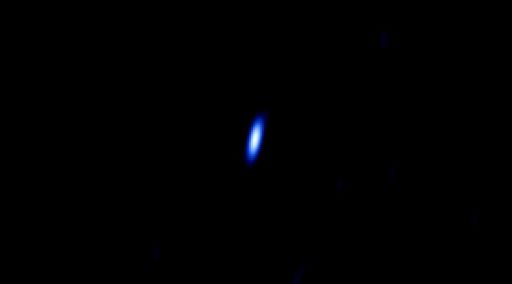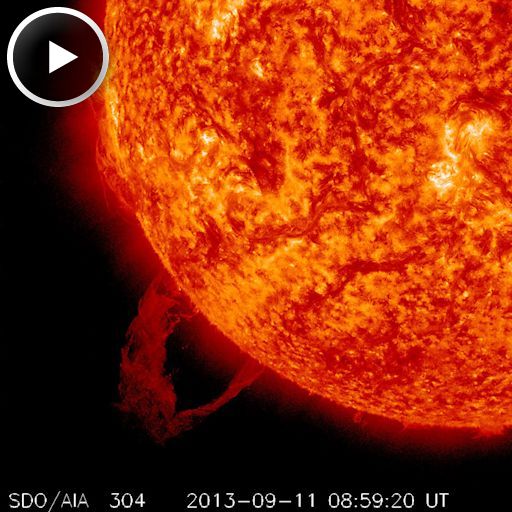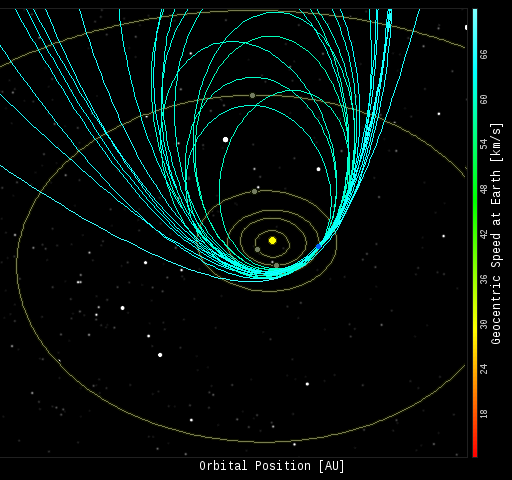When is the best time to see auroras? Where is the best place to go? And how do you photograph them? These questions and more are answered in a new book, Northern Lights - a Guide, by Pal Brekke & Fredrik Broms. | | |
VOYAGER 1 ENTERS INTERSTELLAR SPACE: Researchers have long waited for one of the Voyager probes to leave the solar system. In a surprising turn of events, NASA announced today that Voyager 1 entered interstellar space a whole year ago! This event sets in motion a new era of exploration of the realm between the stars. Congratulations to the Voyager team! [full story]
In February 2012, the National Radio Astronomy Observatory's 5,000-mile-wide Very Long Baseline Array (VLBA) made a radio image of Voyager 1's signal. Little did they know, Voyager 1 was already in interstellar space:

Voyager 1's main transmitter radiates around 22 watts, which is comparable to a typical ham radio or a refrigerator light bulb. Though incredibly weak by the standards of modern wireless communications, Voyager 1's signal is bright when compared to most natural objects studied by radio telescopes.
The image is about 0.5 arcseconds on a side. An arcsecond is the apparent size of a penny as seen from 2.5 miles (4 kilometers) away. The slightly oblong shape of the image is a result of the array's configuration.
The VLBA made this image of Voyager 1's signal on Feb. 21, 2013. At the time, Voyager 1 was 11.5 billion miles (18.5 billion kilometers) away.
SOUTHEAST ERUPTION: Solar activity is low, but not zero. Yesterday, Sept. 11th, a magnetic filament snaking around the sun's southeastern limb rose up and erupted. NASA's Solar Dynamics Observatory recorded the action in a movie which spans 3.5 hours:

The filament hurled part of itself into space, and the Solar and Heliospheric Observatory recorded a bright CME billowing away from the blast site. Earth, however, was not in the line of the fire. The explosion was too far south and east to target our planet. Solar flare alerts: text, voice.
Realtime Space Weather Photo Gallery
METEOR OUTBURST? European sky watchers have witnessed an outburst of September epsilon Perseid meteors. "The outburst occurred around UT midnight on Sept. 9-10," says Bill Cooke, head of NASA's Meteoroid Environment Office. "During a two hour period, meteors appeared at a rate equivalent to ~50 per hour (ZHR). We did not see the outburst in North America because it was still daylight at the time."
NASA all-sky cameras have been recording epsilon Perseid fireballs for days, albeit at a much lower rate than what the Europeans saw. The shower has been active since early September, allowing Cooke's team to calculate orbits for more than a dozen meteoroids:

In the diagram, orbits are color-coded by velocity. Epsilon Perseid meteoroids hit Earth's atmosphere at a "blue-green" speed of about 62 km/s (139,000 mph). According to NASA data, the debris stream appears to be rich in fireball-producing meteoroids.
The epsilon Perseid shower peaks every year around this time, but the shower is not well known because it is usually weak, producing no more than 5 meteors per hour. In 2008 the shower surprised observers with an outburst five times as active, and this year the shower may have doubled even that. Clearly, the epsilon Perseid debris stream contains some dense filaments of material that Earth usually misses but sometimes hits.
No one knows the source of the September epsilon Perseid meteor shower. Whatever the parent is, probably a comet, its orbit must be similar to the green ellipses shown in the orbit-map above. As NASA cameras continue to gather data on this shower, orbital parameters will become more accurately known, possibly leading to a match.
Meanwhile, sky watchers should be alert for more epsilon Perseids in the nights ahead. The shower is waning but still active and more outbursts are possible.
Realtime Space Weather Photo Gallery
Realtime Aurora Photo Gallery
Realtime Noctilucent Cloud Photo Gallery
[previous years: 2003, 2004, 2005, 2006, 2007, 2008, 2009, 2011]
Realtime Comet Photo Gallery

